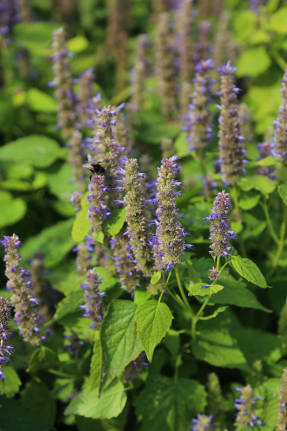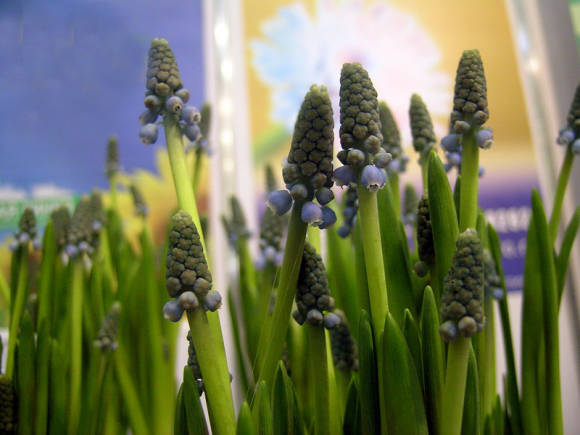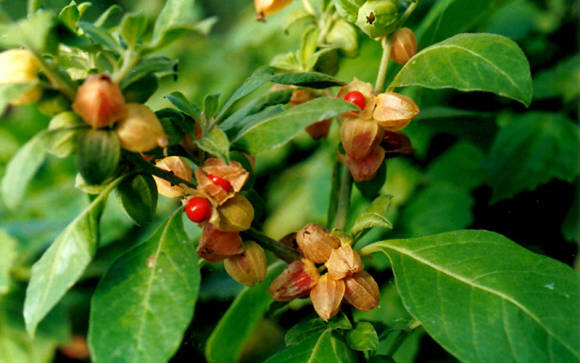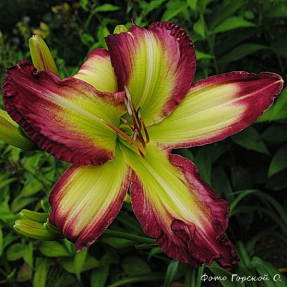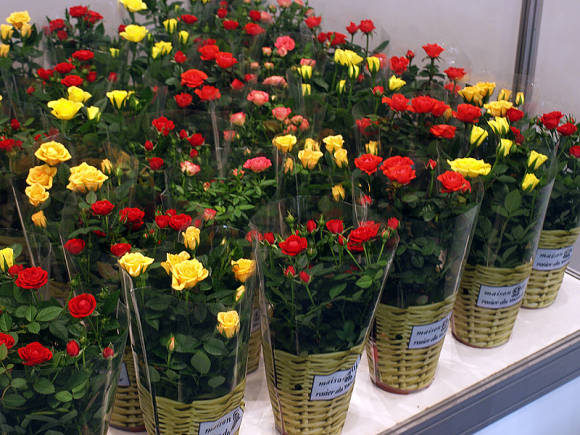Mid-late varieties and hybrids of watermelon
Astrakhan (1977) is a classic oval-rounded striped watermelon. Yield records in Soviet times were set on it. On irrigation, it was possible to get up to 120 tons per hectare. Ripens on 70-85 days from the moment of germination. The fruit is round or slightly oblong, with a smooth surface, weighing 8-10 kg. The bark is green, the pattern is in the form of thorn-like stripes of dark green color. The pulp is bright red, very sweet and juicy. The tastiest and sweetest fruits ripen in late August - early September. In severe drought, voids can form in the fruit that do not affect the taste. It is resistant to diseases, tolerates transportation well, can be stored for two to two and a half months.

Blessed (2010)
Bykovsky 22 (1955) - mid-season (85-90 days) variety of the Bykovskaya melon experimental selection station (Russia). Fruits are spherical, smooth, of medium size, weighing 5-14 kg. The stripes are narrow, slightly spiny. The bark is flexible, strong, up to 1.5 cm thick. The pulp is bright pink, granular, sweet, juicy. The seeds are large, brown. The variety is resistant to powdery mildew and fusarium, transportable. Keeping quality is average.
 Volzhanin (2004) - transportable variety, ripens 80-85 days after germination. Plants are long-leaved (the length of the main lash is more than 3 meters), with narrow, strongly dissected leaves, resistant to drought, low temperatures and diseases. The fruit is broadly elliptical, with a smooth surface, weighing 8-20 kg. The bark is light green with dark green spiny stripes of medium width, occasionally closing. The bark is of medium thickness, strong, and bendable when pressed. The pulp of the fruit is intensely red, grainy, tender, juicy, very sweet. Seeds are small, brown, with a pattern in the form of a black rim, spout and specks. The mass of 1000 seeds is 45 - 50 g. The yield is 300 kg per one hundred square meters.
Volzhanin (2004) - transportable variety, ripens 80-85 days after germination. Plants are long-leaved (the length of the main lash is more than 3 meters), with narrow, strongly dissected leaves, resistant to drought, low temperatures and diseases. The fruit is broadly elliptical, with a smooth surface, weighing 8-20 kg. The bark is light green with dark green spiny stripes of medium width, occasionally closing. The bark is of medium thickness, strong, and bendable when pressed. The pulp of the fruit is intensely red, grainy, tender, juicy, very sweet. Seeds are small, brown, with a pattern in the form of a black rim, spout and specks. The mass of 1000 seeds is 45 - 50 g. The yield is 300 kg per one hundred square meters. Pulse (2004) is a promising fruitful variety (fruits ripen in 75-80 days), drought-resistant. The plant is long-plaited, the length of the main whip is up to 4 m. Fruits weighing 7-14 kg, with a strong bark, red, very sweet pulp, are well transported. The value of the variety is amicable ripening, the variety ripens together, and if the first ripe fruits are immediately removed, the plants will give a second wave of the harvest. The variety is useful for gardeners who decide to make money selling watermelons.
Caravan F1 (2009) - a hybrid of the company "Nunems" (USA). Fruits are elongated-oval, green-striped, with red pulp. Well transported.
Crimson Wonder (2006) - harvest variety, ripens 85-90 days after germination. The fruits are large, weighing 10-12 kg, sweet, with a magnificent red, tender, small seeds, pulp. The bark is light green with dark stripes. Fruit transportability is good. The variety is resistant to disease.
Crimson Record F1 (2010)

Carolyn F1 (2010) - a hybrid with elongated fruits, green bark with stripes, red flesh.
Candy F1 (2011) - early hybrid with oval striped fruits (Crimson Sweet type). The fruits are uniform, the average weight is 9-12 kg, but under optimal growing conditions they can reach 15-17 kg. The extraordinarily powerful growth energy, especially in the initial phases of plant growth, allows you to get a decent harvest even in bad weather conditions. With sparse crops (or with sufficient nutrition), it simultaneously forms several fruits on one bush. The high palatability of the pulp is combined with its delicate granular structure, an unusually sweet taste is a feature of this hybrid. Seeds are small, dark brown. Suitable for growing in the open field and under all types of film shelters. This hybrid forms a powerful leaf cover that perfectly protects the fruit from the sun.
Kimara (2001) - a variety of the Easy Semyon company, yields a harvest at 85-90 days from the emergence of shoots. The main stem is long. The fruit is broadly elliptical, weighing 4.8-6.6 kg. The bark is thick. The pulp is dark red, firm, tasty (sugar content 8.1%). The seeds are brown, small. The seed yield is 0.5%.After harvesting, the fruits remain marketable for 2.5 weeks.

Lotus (1990) - a variety of the All-Russian Research Institute of Irrigated Melons. Ripens on 70-77 days from the moment of germination. Irrigation yield 400-500 kg / are. Fruits weighing 3.5 - 4.0 kg, tasty (sugars up to 9%), shelf life, can be stored for 60 days, transportable. Anthracnose resistant.
Madison F1 (2010) is a vigorous hybrid. Plants form a powerful vegetative mass, providing optimal foliar nutrition and protecting the fruit from sunburn. Each lash grows up to three standard rounded-oval fruits measuring 28x25 cm and weighing 10-13 kg. The thickness of the peel ensures good long-distance transport. The pulp is deep red in color, delicate, fine consistency, high in sugars. The hybrid bears excellent fruit on rich soils, with regular watering and a balanced diet.

Nelson F1 (2010)
Extraordinary (1993) - a productive variety obtained by crossing Charleston Gray and Melitopolsky varieties. Spectacular large, weighing up to 15 kg, dark green, elongated, oval-cylindrical fruits with tasty red pulp ripen 85 days after germination. After removal, they are stored for a month. It tolerates stressful conditions, but in severe drought it can produce pear-shaped fruits. Responds well to watering.
Osceola (1993) - the harvest begins to be harvested after 95-98 days from mass shoots. The plant is long-leaved. The fruits are large, weighing up to 20 kg, with a strong bark and intense pink, sweet, tasty pulp. They transfer the transportation well, they are stored for up to 3 months.
 |  |
Kholodov's gift - medium late transportable, low grade (95-110 days). Fruits are elongated spherical, weighing 4-5 kg. The stripes are narrow, dark green, slightly prickly. The pulp is dense pink or raspberry, dense, juicy, sweet. Seeds are small, light brown. Weakly affected by powdery mildew, moderately by anthracnose. Not in the Register of the Russian Federation.
 |  |
Royal Jubilee F1 - a hybrid of the Siemens firm (USA-Holland) with elongated, exceptionally sweet and tasty, very large striped fruits. Ripens on the 95th day. Transportable. Not in the Register of the Russian Federation.
Svyatoslav (2009)

Celebration F1 (2007) - one of the most vigorous and hardy hybrids of the Syngenta company (USA). The first fruits ripen on the 70th day from the moment of mass shoots. The seeds used for sowing are large, the seeds that form in the fruits are small. Fruits are elongated, green-striped, weighing 10-12 kg. The pulp is very bright, dense, tasty. Lasts 10-12 days.
Sinchevsky (1991) - mid-ripening (85-95 days), amicably ripening variety. The plant is long-leaved. Fruits are large, spherical, weighing 6-18 kg. The pulp of the fruit is intense pink, tender, very sweet. The bark is smooth, with sparse mesh elements, a light green color and a pattern in the form of prickly, occasionally interlocking dark green stripes. The pulp is intensely raspberry-colored, grainy, tender, very sweet, juicy. Seeds are small, black. Without irrigation, it gives up to 400 kg per hundred square meters, with irrigation - 600 kg.

Stimulus (1997) - mid-season variety (85-90 days) for pickling and fresh consumption in August and early September. Fruits weighing up to 15 kg, with a very strong bark and bright pink, excellent-tasting pulp. Differs in stable productivity, good taste, transportability, keeping quality of fruits.
Favorite (2010) - created at the Bykovskaya melon experimental breeding station. Similar to Chill, but more plastic to growing conditions, resistant to stress and ripens two weeks earlier.
(2010) - created at the Bykovskaya melon experimental breeding station. Similar to Chill, but more plastic to growing conditions, resistant to stress and ripens two weeks earlier.
Jubilee 72 (1977) - mid-season (88-95 days) variety for growing outdoors. Fruits are oblong-spherical, smooth with narrow, dark green stripes, weighing 3-10 kg. The pulp is intense pink, sweet, tender, grainy. The seeds are large, creamy. Diseases are mildly affected. Keeping quality is average, transportability is good.
Late varieties and hybrids of watermelon
Spring - a variety intended for cultivation in open ground, greenhouses, including winter ones, and a tunnel. The leaves are large, the main lash is long, the lateral ones are of medium length. Forms well on trellis. Differs in amicable fruiting (fruits are harvested after 105 days). Fruit weighing 2.0-3 kg, elongated spherical, with a smooth surface. The background of the bark is olive green, the pattern is a dense, imperceptible green mesh. The pulp is bright red, grainy, tender, sweet, juicy. Not in the Register of the Russian Federation.
Delight (2008) is a great early variety. Ripens in 95-100 days after germination. The plant is medium-growing. The fruit is round, weighing 5-9 kg. Surface with dark green stripes. The pulp is bright red, grainy, tender, very sweet and juicy.
 |  |  |
Bush 334 (1997) - late ripening (98-110 days) variety with limited shoot growth, large fruits and good yield. Unlike long-leaved watermelons, a bush plant consists of 3-5 shoots up to 80 cm long, therefore it does not take up much space on the melon. Only one fruit weighing up to 8 kg is formed on each stem. The bark is very firm, the flesh is pink, dense, grainy, good taste. The fruits have good transportability and keeping quality (until the New Year), they are used fresh and for salting. The variety is resistant to many diseases. The peculiarity of bush watermelons is very strong seeds. They must be soaked before sowing.
Melania F1 (2010) is a stress-resistant hybrid of the most popular type of watermelon on the market. Early, ripens 80-82 days after germination. The plants are very healthy and adapt to different growing conditions. Fruits are oval, very even in size (23x40 cm), average weight 9-12 kg. The main color of the fruit is green, the stripes are wide, dark green. The pulp is dark red, crispy, the seeds are small. The fruits are well adapted for transportation. The recommended planting density is 9-10 thousand plants / ha.

Chill (1990) - the most common of the late-ripening domestic varieties. Created at the Bykovskaya melon experimental selection station. The first fruits ripen in 100 days. The plant is powerful, with large leaves, long-leaved, the length of the main whip is more than 5 m, so the plants are placed according to the scheme 70x150 cm. Fruits are large, weighing 15-25 kg, elliptical or elongated-spherical, weakly segmented, with a strong green bark with black green, medium-wide stripes and intense red, with a pink tint, very sweet flesh. Productivity - 300 kg per one hundred square meters. The fruits do not overripe on the melon, are well transported, stored for more than 3 months, provided that they were removed by hand, laid on racks with soft bedding in a dry room with a temperature within 0 + 10 ° С. The fruits are mostly eaten fresh, but they can also be salted and pickled. In severe drought, after ripening, watermelons are slightly fried. Can be grown through seedlings (sowing seeds at the end of April). When grown in a greenhouse, the plants are tied to a trellis, all lateral shoots are removed to a height of 50 cm, the subsequent ones are pinched over 1-3 leaves.Moderate watering, especially during fruit ripening. Susceptible to an average degree to anthracnose, powdery mildew, fusarium.
Black Prince (2009) - medium late (85-95 days from germination to maturity) variety intended for cultivation in film greenhouses and open field, with excellent taste. Fruits are cylindrical in shape, weighing 7-9 kg, with a dark green, elastic bark of medium thickness and bright red, very sweet (sugar content up to 10.4%) pulp. Seeds are medium, black. Sowing for seedlings is carried out at the end of April, they are planted in a permanent place at the age of 35 days. They grow in the greenhouse in the same way as Chill. Jubilee is a late ripening variety of watermelon. The fruits are oval, 60 cm long and 30 cm in diameter. The pulp is fragrant. Not in the Register of the Russian Federation.
See also:Early varieties and hybrids of watermelon
Mid-season varieties and hybrids of watermelon
Recommendations for the selection of varieties and hybrids of watermelon
Is the watermelon a green striped ball?

